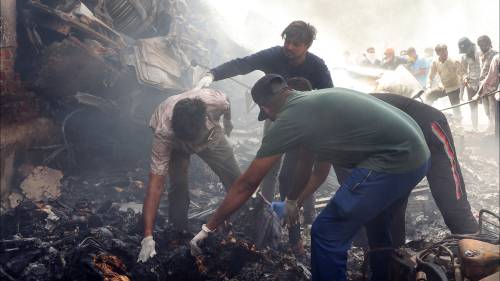The aviation community was shaken Tuesday when Air India Express flight IX-1344 crashed while attempting to land at Kozhikode International Airport in Kerala, claiming dozens of lives in one of India’s worst air disasters in recent years. The Boeing 737 aircraft, carrying 242 passengers and crew, skidded off the runway amid heavy monsoon rains, plunging into a 35-foot gorge before breaking into two pieces.
“The aircraft overshot the runway in difficult weather conditions,” confirmed India’s Directorate General of Civil Aviation in an initial statement. “Visibility was severely compromised at the time of landing, with reports of intense rainfall in the region.”
First responders worked tirelessly through challenging weather conditions to rescue survivors from the wreckage. According to Kerala state officials, at least 18 people, including both pilots, have been confirmed dead, while dozens more remain in critical condition at local hospitals. The passenger manifest included 10 infants and 174 adults, many of whom were returning home on a repatriation flight amid ongoing COVID-19 restrictions.
Aviation experts from CO24 News have noted that Kozhikode’s tabletop runway—built on elevated terrain with steep drops on either side—presents unique challenges for pilots, particularly during adverse weather conditions. Similar geographic features were factors in previous Indian aviation incidents, including the 2010 Air India Express crash in Mangalore that killed 158 people.
“Tabletop runways leave little margin for error,” explained Captain Mohan Ranganathan, a former commercial pilot and aviation safety consultant. “When combined with heavy rain and reduced visibility, even experienced pilots face extraordinary challenges during landing approaches.”
The aircraft’s black boxes have been recovered and will be crucial in determining the exact cause of the accident. India’s Aircraft Accident Investigation Bureau has dispatched a team to the crash site, while Boeing has offered technical assistance to the investigation.
This tragedy comes during a particularly challenging period for Air India, which has been navigating financial difficulties while managing repatriation flights during the global pandemic. The airline has been instrumental in India’s Vande Bharat Mission, bringing home thousands of citizens stranded abroad due to COVID-19 travel restrictions.
Prime Minister Narendra Modi expressed his condolences on social media: “Pained by the plane accident in Kozhikode. My thoughts are with those who lost their loved ones. May the injured recover at the earliest.”
International aviation authorities, including the International Civil Aviation Organization, are closely monitoring the investigation as it unfolds. The crash raises critical questions about aviation safety protocols during extreme weather events—a growing concern as climate change potentially increases the frequency and severity of such conditions worldwide.
As recovery efforts continue and investigators piece together the final moments of flight IX-1344, one must wonder: how will this tragedy reshape aviation safety measures for India’s challenging airport infrastructures, and what lessons can be applied globally to prevent similar disasters in the future?










